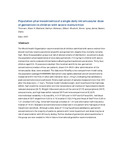Population pharmacokinetics of a single daily intramuscular dose of gentamicin in children with severe malnutrition

View/
Date
2007Author
Thomson, Alison H
Maitland, Kathryn
Kokwaro, Gilbert
Muchohi, Simon
Ignas, James
Seaton, Claire
Type
ArticleLanguage
enMetadata
Show full item recordAbstract
The World Health Organization recommends that all children admitted with severe malnutrition should routinely receive parenteral ampicillin and gentamicin; despite this, mortality remains high. Since this population group is at risk of altered volume of distribution, we aimed to study the population pharmacokinetics of once daily gentamicin (7.5 mg/kg) in children with severe malnutrition and to evaluate clinical factors affecting pharmacokinetic parameters.
Thirty-four children aged 0.5–10 years were studied. One hundred and thirty-two gentamicin concentrations (median of four per patient), drawn 0.4–24.6 h after administration of the intramuscular dose, were analysed. The data were fitted by a two-compartment model using the population package NONMEM®.
Gentamicin was rapidly absorbed and all concentrations measured within the first 2 h after administration were > 8 mg/L (indicating that satisfactory peak concentrations were achieved). Ninety-eight percent of samples measured more than 20 h after the dose were < 1 mg/L. The best model included weight, and it was found that high base deficit, high creatinine concentration and low temperature (all markers of hypovolaemic shock) reduced clearance (CL/F). Weight influenced volume of the central (V1/F) and peripheral (V2/F) compartments, and high base deficit reduced V2/F and intercompartmental CL (Q/F). Interindividual variability in CL was 26%, in V1/F 33% and in V2/F and Q/F was 52%. Individual estimates of CL/F ranged from 0.02 to 0.16 (median 0.10) L/h/kg and those of Vss/F from 0.26 to 1.31 (median 0.67) L/kg. Initial half-lives had a median of 1.4 h and elimination half-lives and a median of 14.9 h. Excessive concentrations were observed in one patient who had signs of renal impairment and shock.
Although a daily dose of 7.5 mg/kg achieves satisfactory gentamicin concentrations in the majority of patients, patients with renal impairment and shock may be at risk of accumulation with 24 hourly dosing. Further studies of gentamicin pharmacokinetics in this group are now needed to inform future international guideline recommendations.
URI
http://www.ncbi.nlm.nih.gov/pubmed/17347177http://erepository.uonbi.ac.ke:8080/xmlui/handle/123456789/47348
Citation
Journal of Antimicrobial Chemotherapy Volume 59, Issue 4 Pp. 681-689 (2007)Publisher
Department of Pharmaceutics and Pharmacy Practice
Collections
- Faculty of Health Sciences (FHS) [10378]
